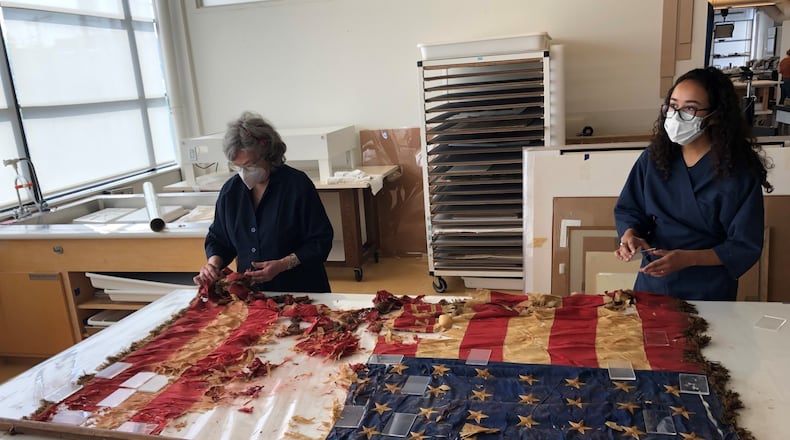This July, preservationists in Cleveland meticulously unrolled that flag that had been in a Butler County basement since the 1950s from its pole in a process that took five hours. It may have been the first time since the regiment retired the damaged flag after the Battle of Missionary Ridge, near Chattanooga, Tenn., in November 1863 that it was seen.
Even after it was rolled up and replaced, the flag still accompanied 35th Regiment soldiers recruited from Butler, Warren, Montgomery and Preble counties until the regiment mustered out at Chattanooga in September 1864, during the Atlanta Campaign.
“I think it’s one of the more important county artifacts that we have, certainly the most important Civil War artifact I believe we have,” said Brian Smith, president of the Butler County Historical Society. “It needed to be saved, because it was just deteriorating. It also needs to be seen and appreciated.
“It’s not just a local artifact, it’s a national artifact. I don’t know how many of these flags exist in the country.”
Smith used heavy moving pads, bed sheets, bubble wrap and tape to prevent damage on the drive to Cleveland. One end of the flag’s pole touched the windshield of his Toyota Highlander while the other end rested across the seats.
The society’s board has decided to preserve the flag and display the original, rather than a reproduction. That will cost tens of thousands of dollars, with estimates not yet complete, and about 18 months of work. The society will raise money privately and seek grants to pay for it.
Proud history
“Probably the 35th’s highest point, or most glorious day, was at the Battle of Chickamauga (in Georgia), and that flag was there,” Smith said.
According to “Fantastic Shadows Upon the Ground,” a book by the late Hamilton author Greg Fugitt, the regiment’s soldiers spent their first two years near the edges of the war “before proving they were among the best of combat soldiers at Chickamauga and Missionary Ridge.”
Ferdinand VanDerveer of Hamilton organized the unit during August and September of 1861. He started in the U.S. Army as a colonel and become a general.
Volunteers at the society are now starting to search for living descendants of the regiment, starting with the officers. People who think they may be related can call Kathy Creighton, the historical society’s executive director, at 513-896-9930.
There is also a Civil War reenacting unit in northern Ohio that chose the 35th as their regiment, “so there must be some tie there,” Smith said. “We’re going to contact them.”
Unlike most American flags, this one is about 75 inches tall and 72 inches long, Smith said. It was made that way because it’s easier to control a flag in battle that doesn’t have its center of gravity too far from the pole.
After the dirty, worn and damaged flag was retired, troops called it “The Old Invalid,” Smith said. “It still traveled with the unit, everywhere. It just never was unfurled after that.”
Credit: Nick Graham
Credit: Nick Graham
A flag’s winding path
When the 35th Regiment left for war in 1861, ladies of Hamilton provided what was called a “storm flag,” a smaller version of the American flag that could be flown in bad weather.
After leaving Hamilton, the regiment was assigned to protect bridges and railroads in Northern Kentucky. While the troops were there, women of Cynthiana, Ky., made and gave them the larger, more ornate flag.
After the war was over, the flag was presented to Gen. VanDerveer, who brought it back to Hamilton. When he died, his daughter Susan inherited it.
“It was in all the local parades, so when they did Decoration Day or unit reunions, that kind of stuff, the flag was there. It was just never, ever unfurled, because of its condition,” Smith said.
A great grandson of VanDerveer donated the flag to the historical society sometime between 1955 and 1957 after it had been kept in post-war years in Ohio, Michigan and California.
From then until this year, it was kept in the historical society’s basement.
A very difficult war
“The 35th’s numbers dwindled from about 900 men who had mustered in to only 300, effective by September of 1863,” Smith said.
“More guys actually died of disease than from battle in the Civil War, and that’s pretty much across the board. That did more damage than actual fighting, for both sides, actually.”
Smith said the regiment had five officers and 75 enlisted men killed or mortally wounded. Another two officers and 126 men died of disease. Combined, those numbers added up to 208 deaths.
Many others were sent home because of injuries and other problems, accounting for the severe losses.
Smith visited many cemeteries across Butler County. At “almost every single one I found at least somebody from the 35th.”
Flags were not only important for morale reasons during the Civil War, but in commanding units during battles. Standard-bearers carried flags of the country, the state and their units so commanders could see where soldiers were deployed. Troops would fire at soldiers holding the flags, hoping to create chaos among the enemy.
“If one guy should happen to go down, who was the flag-bearer, the next guy who was in line for that position would grab it, and so forth,” Smith said.
Delicate Work
Jane Hammond, the textile conservator for ICA-Art Conservation, which she calls the oldest non-profit art conservation facility in the midwest and maybe the country, said the fragile silk had a texture similar to wet tissue paper.
It took two people five hours to unroll the flag. More hours of careful jigsaw puzzle-type work are ahead, piecing together other parts. Even then, a broad strip will remain across the flag, where the twine for years cinched the silk together, almost powderizing it.
“It’s probably one of the more deteriorated flags I’ve ever seen,” she said. “I was a little shocked at its condition — nobody knew what to expect.
“Our goal will be to stabilize and preserve what’s there,” and remove dirt and other contaminants that would deteriorate it further.
The goal is to have it framed by a specialized company.
Historians hoped to keep it at Butler County’s Soldiers, Sailors and Pioneers Monument in Hamilton, but there’s no room to show it without it covering names on the walls. Instead, the society plans to display it in its newly renovated auditorium.
“We don’t want to have it conserved and stabilized, and then rolled back up, put in a plastic tube and kept in our basement again for another 100 years without anybody seeing it,” Smith said.
About the Author


